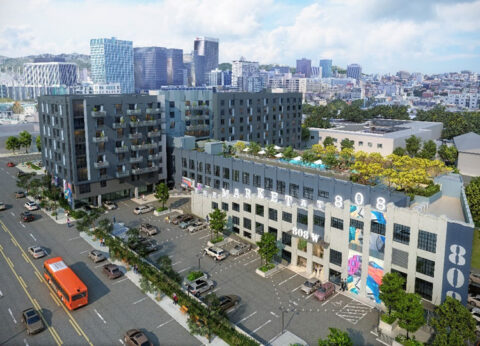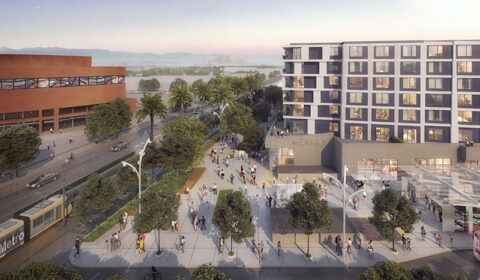Top Story
Op-Ed published in Urbanize LA: The Morning After Declaring a State of Emergency - Confronting The Realities of Homelessness
by Rick Cole and David Waite, ULI-LA Members and Homelessness Initiative Council members
January 11, 2023

Photo By KTGY
KTGY’s design of Western Station for Jamison Properties LLP in Los Angeles incorporates a parking garage (rehabilitated for parking, retail, and rooftop amenities) with new multifamily housing. With 139 spaces, the project is parked at 0.5 spaces per unit, below normal for Los Angeles because of incentives from Metropolitan Transit Authority.
It’s well-established that California suffers one of the most pernicious housing crises among the states. Rampant unaffordability, ever-increasing numbers of unhoused, and battles between housing advocates and neighborhood opponents are rampant. But recently the state has taken robust legislative steps toward stemming these calamities.
“Within the three weeks after the most recent legislative session, Governor Gavin Newsom signed no less than 37 bills aimed at housing regulation and local control,” says David P. Waite, partner, Los Angeles office of Cox Castle Nicholson, and former ULI Los Angeles chair. “It’s part of his mandate as re-elected governor and he’s all over it, very aggressively.”
While Waite believes some of these bills will become tied up in the courts, there is one piece of legislation that holds fascinating promise. Assembly Bill (AB) 2097 removes minimum parking requirements for housing developments within one-half mile of a major transit stop. As Waite says, “That can be a metro station, it can even be a bus line at the intersection of two bus lines with 15-minute headways. So essentially, that’s taking away parking requirements in the major metros.”
Prior to this long-sought legislation, cities could require developers to provide a least one parking space per tenant. For decades, this drove up the cost and timelines of building, and likewise increased rents and mortgages.
“Overparked” Cities Remove Mandates
In addition to California’s statewide move, major cities have already removed many parking mandates. San Jose, which studies have shown to be one of the most “overparked” cities in the state, recently reversed its policy requiring extensive parking for both commercial and residential development. San Francisco and San Diego recently eliminated parking minimums altogether. In 2016, Oakland removed parking requirements near major transit corridors. Los Angeles has no citywide elimination of mandates, but does encourage significantly reduced parking at affordable/supportive housing developments and transit-oriented developments.
Michael Manville, associate professor of urban planning at the UCLA Luskin School of Public Affairs, recently presented a paper to UCLA Ziman Center for Real Estate about the benefits of removing parking requirements.
“A sizable [amount of] research literature suggests they undermine housing affordability, encourage driving, and discourage walking and public transit use,” states Manville. “Rolling these requirements back is thus a big change, and essential to meeting California’s affordability and sustainability goals.”

Photo By Ethos Real Estate
Crenshaw Crossing had the option of providing no parking, but neighborhood concerns contributed to a decision to include one space per dwelling unit. Rendering by Ethos Real Estate.
Parking Flexibility
Importantly, the new law does not forbid parking, it simply gives developers the option. If they believe their project will be more successful with partial or complete parking, they are free to create it. (They may, however, still face prohibitive community and lender resistance.)
Past mandates often reduced the number of units for which a parcel is nominally zoned, says Manville. For example, a parcel zoned to allow 20 units may have been reduced to 15 units because the mandates made it impossible—financially or logistically—to fit 20 units plus their required parking spaces onto the lot.
Don’t have an account? Sign up for a ULI guest account.